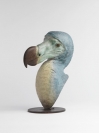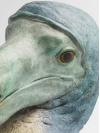
Dodo Head
By Nick Bibby- Size:
- 15.5 × 33 × 24.5cm
- Medium:
- Bronze
- Edition size:
- 10
Raphus cucullatus
The Dodo has become an icon of extinction, perhaps because its extermination was entirely the result of its brief contact with Man. An overgrown ground pigeon, apparently helpless and comical in appearance, the Dodo has exerted a profound influence on our imaginations.
Current scientific opinion classifies it as a member of the pigeon order, and research into its anatomy confirms it to be a giant, flightless pigeon. The cost of flight in terms of a bird's energy is very high, with flight structures comprising as much as one quarter of total body weight. Where flightlessness occurs there is an increase in weight and development of the legs, often combined with a tendency to giganticism.
Island species develop these characteristics relatively quickly which is not surprising when considering that many of the changes are a selection for keeping neotenous, or juvenile characteristics: loose downy feathers, small wings and flight structures. It is easier to imagine the evolutionary changes manifested by the Dodo when comparing it to a pigeon
squab rather than an adult bird.
In their rich, predator-free environments, often without competitors, islands have become hothouses of evolutionary activity and the Mascarenes are an exceptional example of this.
From an early time the Dodo has been the subject of many paintings, drawings and lithographs. However it is difficult to know whether these works were drawn from life or copied,
or were taken from dead specimens or captive, overfed individuals.
To reconstruct the bird with anatomical precision we have researched the surviving skulls, bone and skin. Together with contemporary accounts and illustrations we have created the most accurate three-dimensional representation to date.



